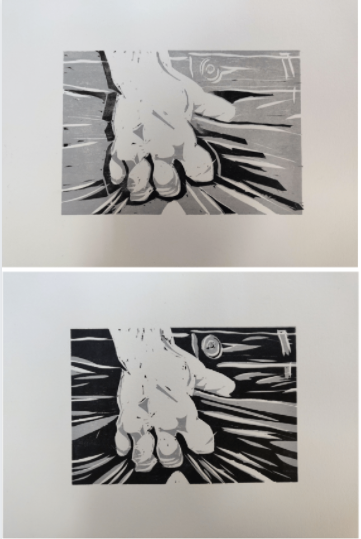Images
On this page you will find all of the images submitted to the Queering the Quarantine project. There is a wide variety of content here including photography of the self, artwork, photographs that capture something tangible or physical, GIFs and text based content. We encourage you to take a look through and to experience, just for a moment, a snap shot of queer life in lockdown.
These images were produced as contributions to the collaborative project on Instagram @boisofisolation. This is a space in which others were invited to share selfies where they queer gender binaries in pandemic times and places. A.C. Davidson and Dawn Woolley sought to be participants in the project, as well facilitators. They wished to create an online community and explore shared experiences of gender and/or queerness in the pandemic through the queer language of selfies.
During the pandemic they began to experiment with queer visual techniques, identifying visual tropes of superimposition, montage, mirroring, image degradation, and the digital glitch. When uploading their selfies to their phones, they produced new images - glitches. These unexpected images do exactly what they wanted the photographs to do: represent bodies in ways that are ambiguous and may require time and care from the viewer to decode. They may even subvert a 'decoding' altogether. You can find a blog post with more in-depth details about the project here.
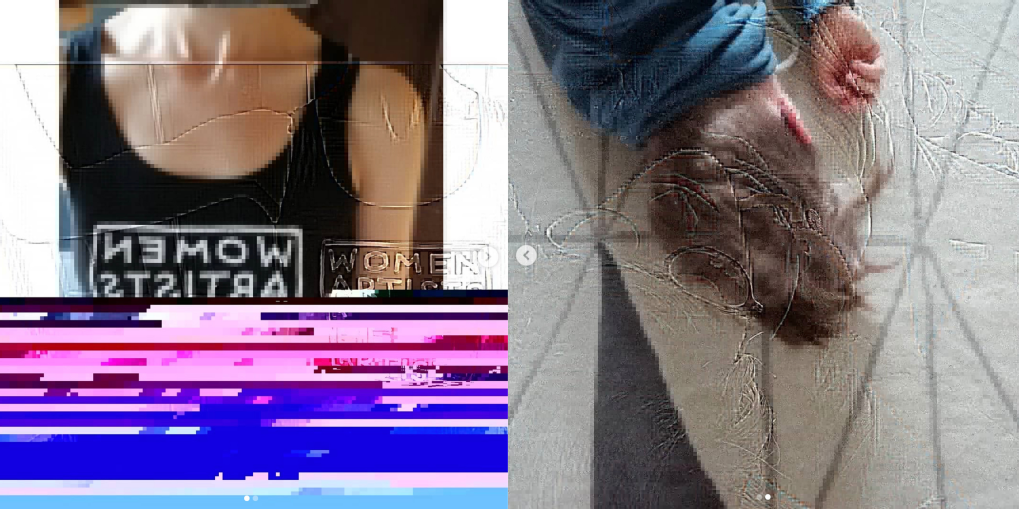

Adrian is a gay medical student at the University of Warwick. During quarantine he used his time away from clinical responsibilities to focus on research.
His research focuses on the use of HIV Pre-Exposure Prophylaxis (PrEP) in Men-who-have-Sex-with-Men (MSM), specifically how to optimise uptake within ethnic minority communities.
He believes this research is too scientific as it currently stands and so designed this the infographic featured below as this more broadly addresses concerns regarding PrEP within the gay community as well as the public and professional sphere.
Adrian's full submission is available in pdf form HERE.
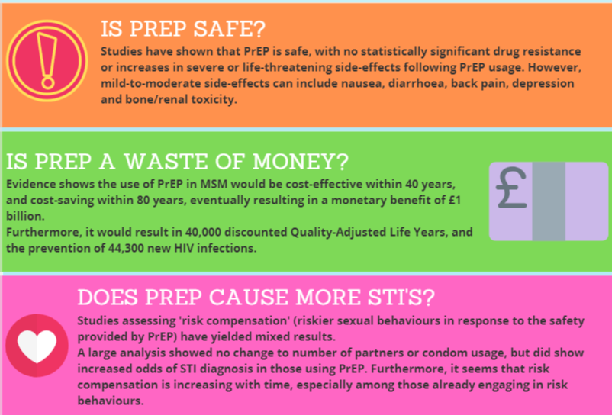

"These online parties will no doubt inform the future of nightlife when queer spaces IRL eventually begin to open, but until then we can dress up our rooms, by ourselves; pour a drink and enter the party."
Aidan produced the piece below to explore online communities, isolation, and queer resilience. When nightlife venues across the UK were forced to shut in March 2020, many online 'club' spaces arose. From the weekly Queer House Party to Club Quarantine's nightly gatherings; these virtual club nights offered a lifeline to queer people in isolation, allowing them to connect again in an otherwise lonely time. Digital spaces can also be more inclusive than their real life counterparts, allowing those with access needs to join at their own pace. At any one time hundreds of attendees from across the world can be seen on screen dancing, singing, chatting and connecting with each other, unrestricted by geography or venue limitations.
This submission is a testament to these online communities and how important they have been for those without access to their queer circles. A contrived set is shown with clashing black and white patterns, and a figure holding a glass of wine is faintly illuminated by a laptop on their knee. The figure, dressed all in white with angel wings and silver make-up is the performing persona AIDAN STRUDWICK. This character is informed by the individual's experiences in queer spaces, and exists mostly within the context of nightlight itself, but now, AIDAN STRUDWICK is all dressed up with no where to go. There is undoubtedly a bittersweet tone as a disco ball sits timidly and a username extends along the length of the floor, but ultimately these online spaces showcase the resilience of the community itself, and the determination to find ways to connect.
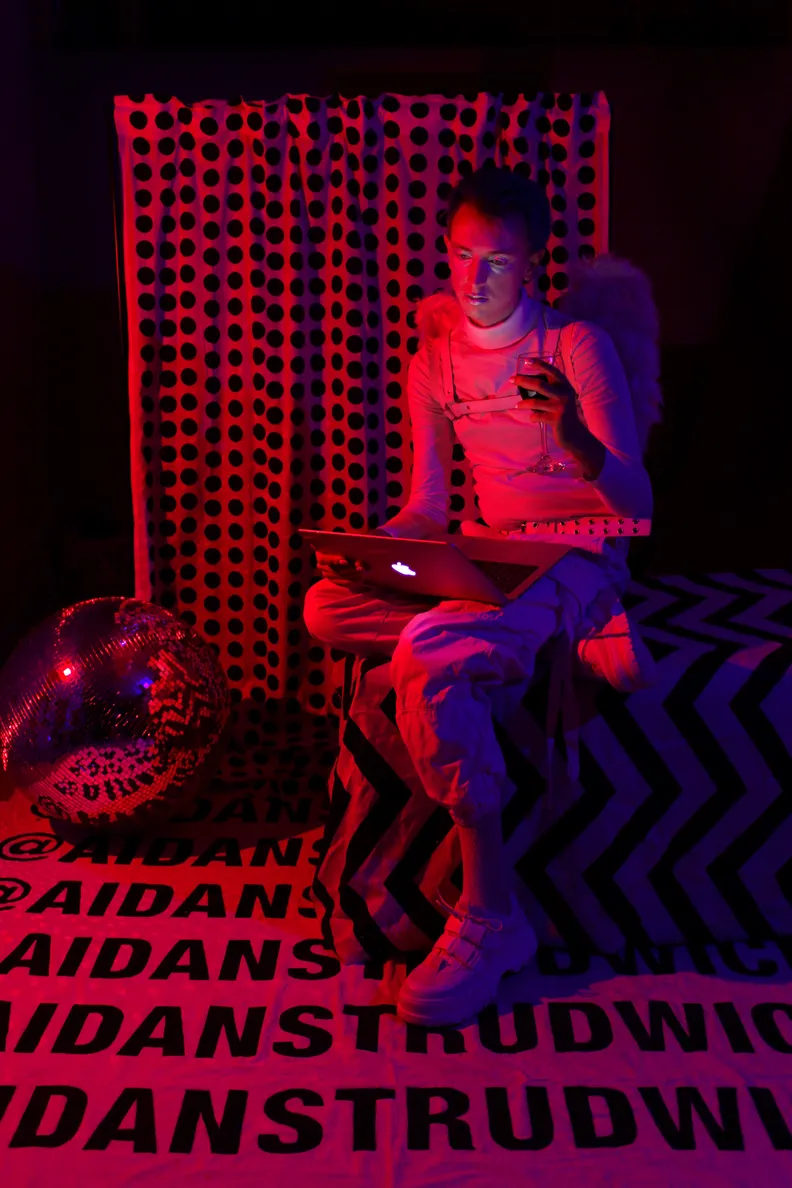

Lockdown: Mourning
"When lockdown started I struggled with mornings, I would wake up, lay in bed waiting for 9am when it was time to log on for work. Days quickly lost structure and my mental health began to slip. I find myself wanting the old routines that signify to my brain the passage into productive head space. The morning shower, dressing, leaving the house, the journey to work, my morning office coffee with colleagues.
This image is a reflection of my lockdown mornings. Waking, dressing but with no where to go. Once I made myself get washed and dressed rather than living in PJs [pyjamas] I noticed that the clothes I was choosing to wear, were more androgynous. For me they are my comfy clothes, what I feel at ease in when in my own space.
It got me thinking about how I unconsciously select clothes that tether me to my assigned gender when I know my body is being viewed for public consumption. But in my own space I am most myself feeling betwixt and between. My favourite outfit being my dungarees, and living in sports bras.
I wonder when I return to full time office work, my gender presentation again for public consumption, if I will also return to my past habit of gendering myself or if the sports bra, and boyish comfort, will go with me."
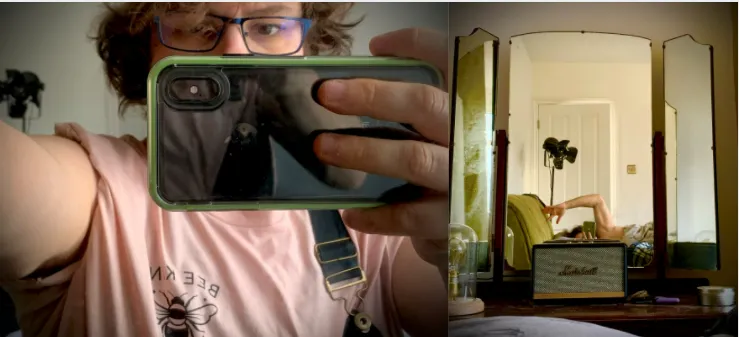

All of the photography in this submission was taken between the first and second lockdown. They all feature Amber's queer friends and support networks.
"The people have been the light in a very dark quarantine, and I am lucky to have them all by my side."
At the start of August, when the rules about numbers of people and households mixing were doing the Hokey Pokey, I got two of my most amazing support networks at university together – my housemates and my friends.
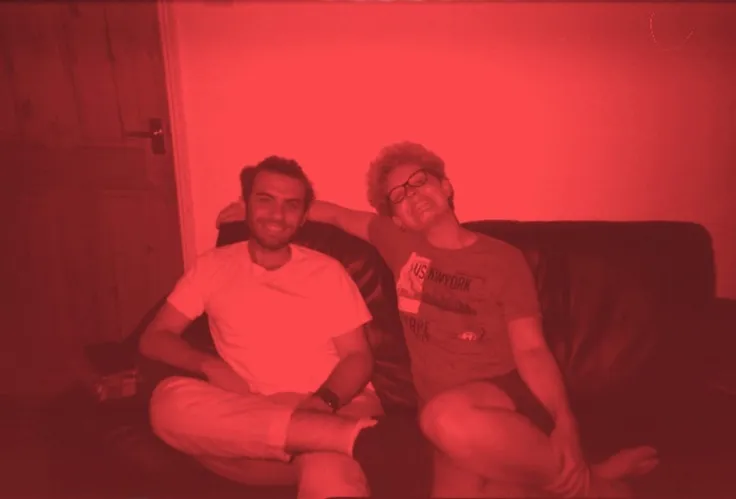
My trans boyfriend, Oliver, (right) and our mutual friend, Mustafa, (left.) Me and Ollie have jokingly dubbed the three of us disaster “bisexuals”, because Mustafa is the only one insisting he’s still straight.
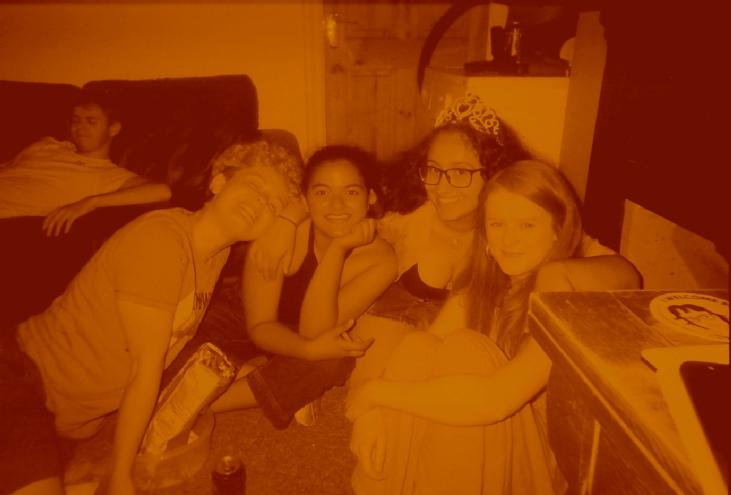
From left to right, David trying to hold his alcohol, Ollie, Christa, a Princess (who I promise isn’t me) and Bex.
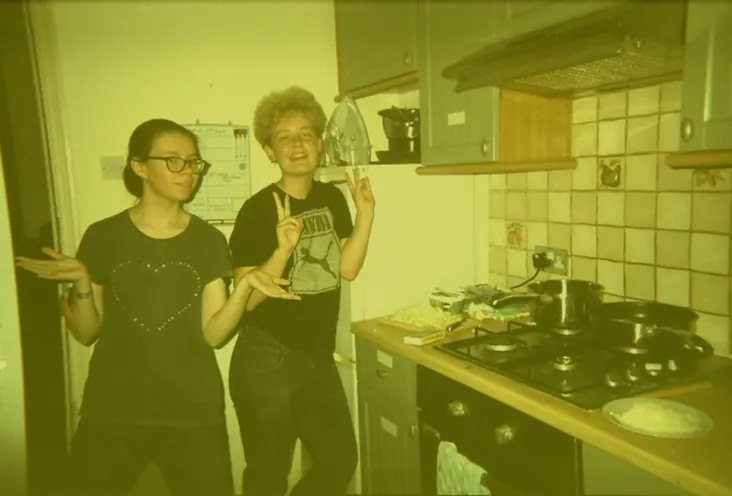
Abi, nonbinary, (left) and Ollie posing by an amazing, quickly-finished risotto. You can joke with us that gays can only either do maths or drive, not both, but you can never question our cooking skills. At least to our faces.
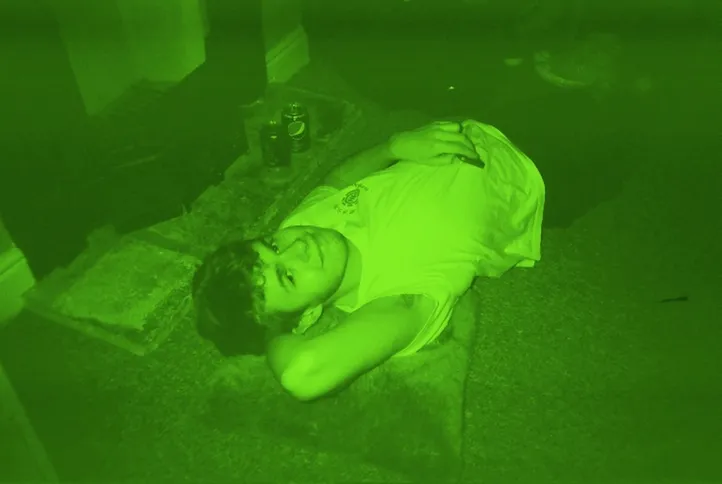
David posing for his first, soon-to-be-released indie album that he has titled ‘On the Floor Laughing.’ Pre-order now.
Disclaimer: album does not exist.

Anna, my housemate, and I.
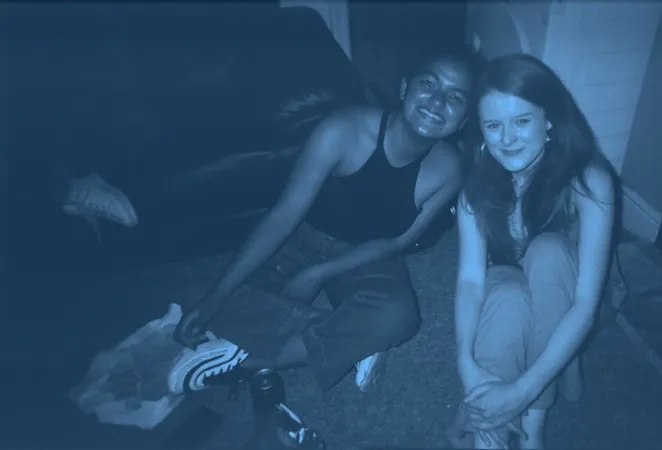
Bex and Christa, both from my different support networks, bonding over astrology.
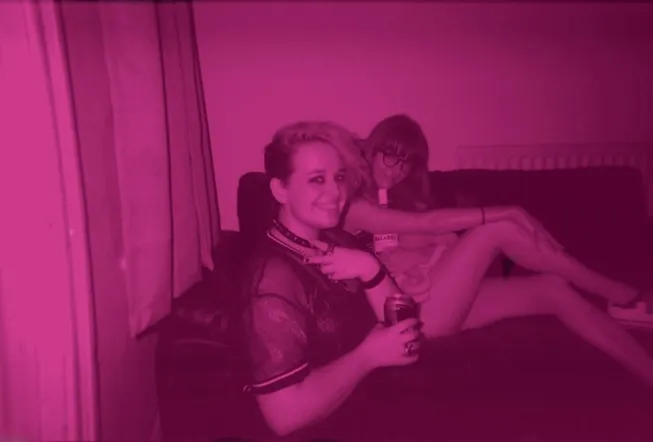
From right to left, Lucy, and her nonbinary housemate Milo. The both of them are very cool, and back when COVID wasn’t a thing we’d always pre-game at theirs.
In September, I went to see my army of gays – a title I think all of us emotionally constipated folk would prefer to chosen family – in Brighton. Left to right on the top row, Caleb, Ciara, myself, Jaimie and Hamza are pictured. We spent the whole weekend looking after dogs, drinking by the sea and playing games. A couple of the photographs are also my housemates and I, being the poor students that we are, taking advantage of the Eat Out to Help Out scheme.
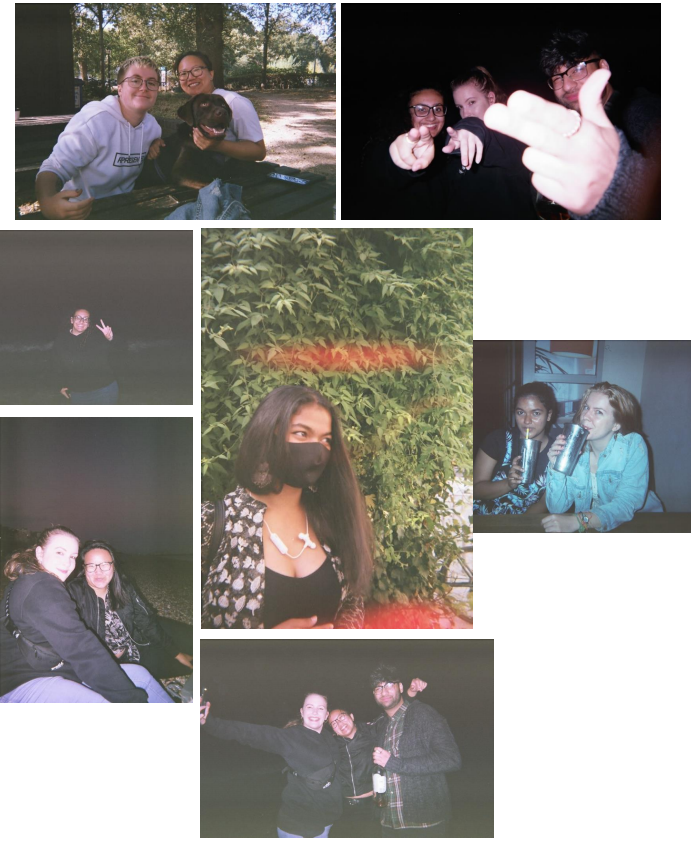

Anya's work was made when there a huge transphobic discourse happening with JK Rowling's tweets and the proposed repealing of healthcare for trans people in the US and UK. These posters were a response to the huge amount of frustration that Anya was feeling. In quarantine, they simultaneously felt more isolating in their gender, but also more comfortable, and so these are some of the message that they wished to be reminded of as their feelings fluctuated.
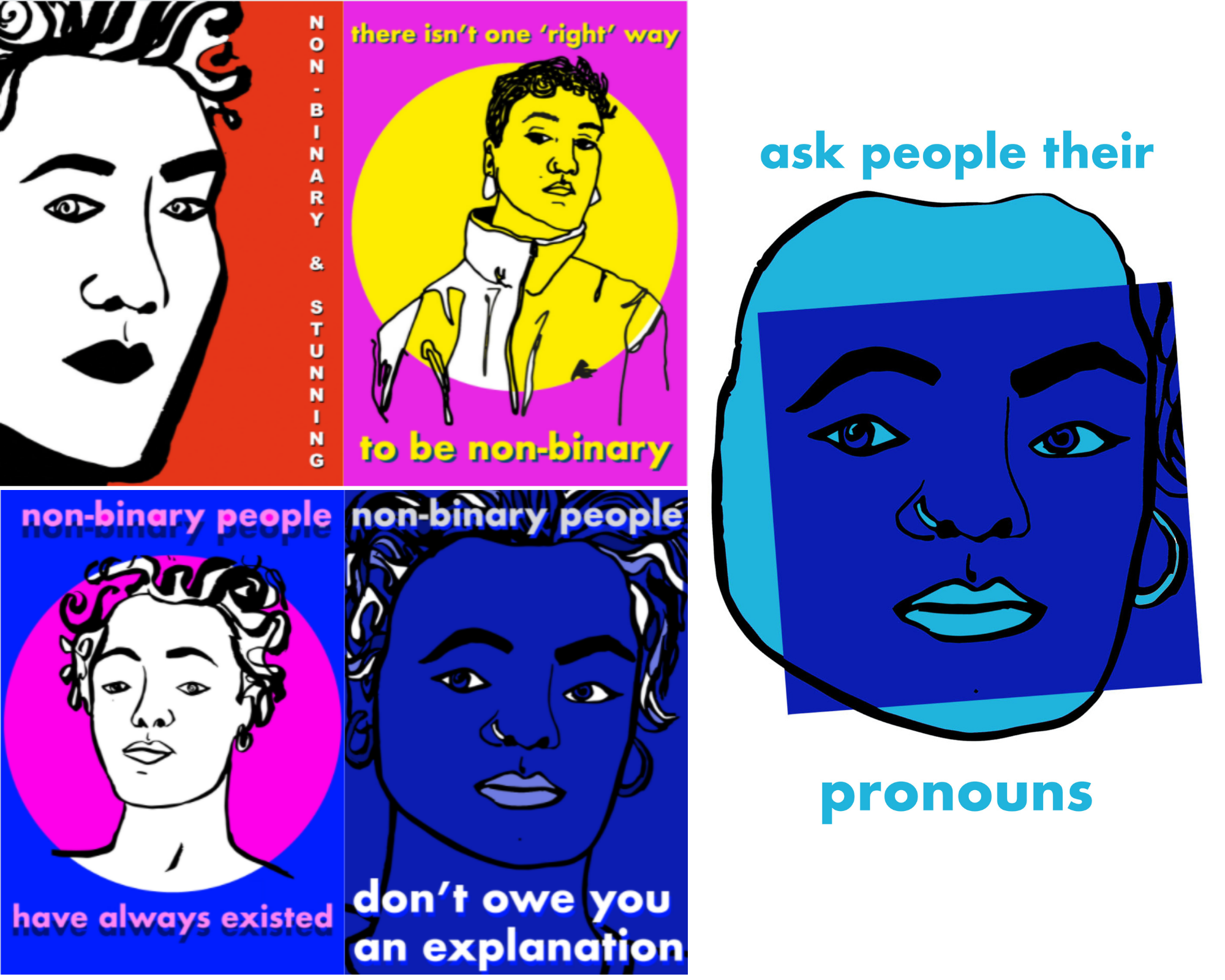

These photos are an expression of Anya's and Minnow's identities and queerness. They also convey a sense of dressing for oneself. 'Diamonds in the Ruff' was an idea that they had formed in the past two years, and in March 2020, with everything on pause - jobs, life in general - it felt like the time for the "inevitable ruff reveal". They had done a photoshoot just before the lockdown hit and spent March editing and getting the images ready for Instagram. For three months that had gotten dressed in separate bedrooms, made ruffs, sewed and had Zoom meetings together. At the time of submission, they lived together and were able to take these photos in the same place. Their Instagram documents this process.
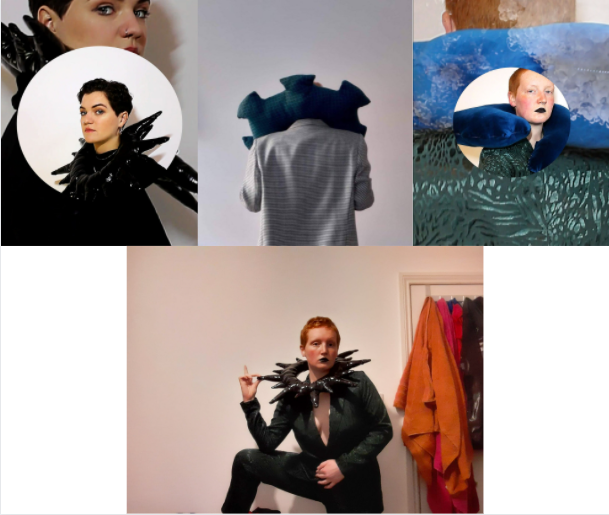

"Being queer to me means using your imagination, and following whatever daft whims bring you delight, relief and laughter, because you can't take that for granted."
Being queer involves resilience and the ability to find joy in unlikely circumstances. Being stuck in the same house all day makes you feel trapped, but in early lockdown April had a space she would lock herself in, and in the ultraviolet light it felt like a completely different place. April used it to dance like Lady Gaga ("badly"), and using that energy helped her stave off depression. April once even livestreamed a dance party from in there. He and her friends did the dance to the Ukraine 2007 Eurovision entry over Zoom ("you'll know the song when you hear it"). The rave toilet comes with tiny neon dinosaurs, and complementary sambuca.
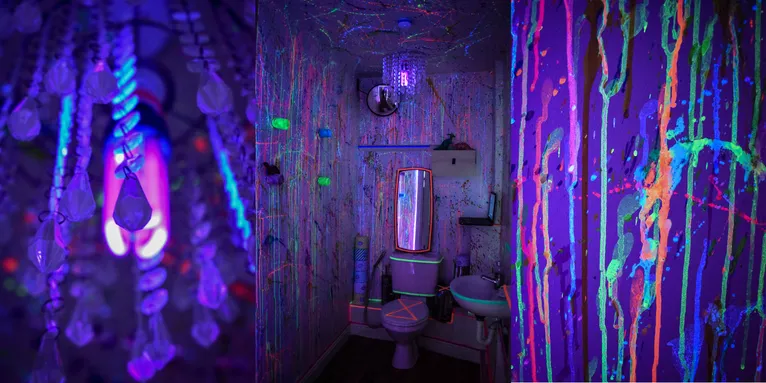

Ash has taken part in building communities from the ground up that they could have never even imagined during quarantine. Several of these are queer communities. The 2020 quarantine was a rough time to be transgender and these communities helped support Ash through thick (Elliot Page coming out) and thin (Gender Recognition Act consultation, JK Rowling and the Bell v Tavistock judgement for underage people trans people seeking puberty blockers).
These communities have been there for Ash every step of the way and they wanted to immortalise that in the form of art, to remind them that although it has been a rough year, they have always had the wind of their queer, chosen family at their back.
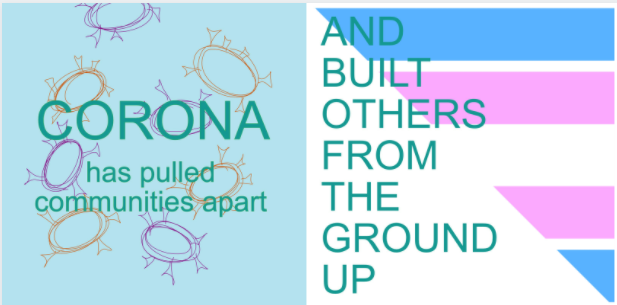

Below is the finale image for QHF Pride Parade 2020, which was edited by Cas and features eight members of the Queer Heritage Forum, who helped to create PrideOnline2020 – (top left to bottom right is Ben Paites, India Divers, Myla Fish, Claire Mead, Cas Bradbeer, Jack Shoulder, George Doji and Danny Tokay Reid). This group facilitated collective queering of the quarantine by asking people to share images and videos of what they would have liked to have done at a physical Pride Parade. These submissions were shared throughout the week on Twitter, where anyone could scroll through our stream of queer content as if watching the parade go by. To conclude both the virtual parade and, more broadly, the week of QHF’s queer events, podcasts, videos, craftivism activities and much more, they put together this photocollage and sent it out, accompanied by a note of thanks to all who took part.
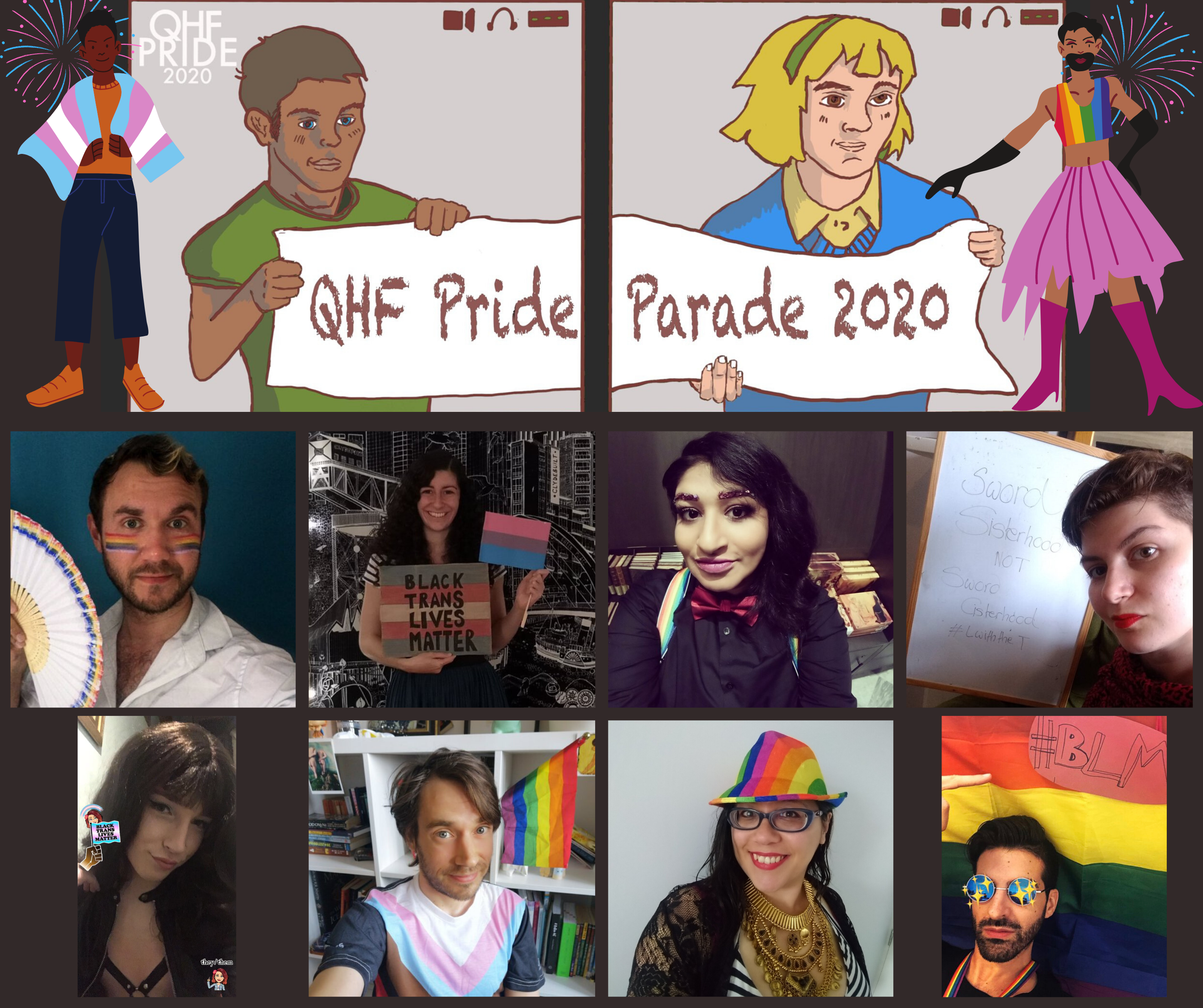

Progress Flag Tea (2020)
Acrylic on an old cotton shirt.
Chaya painted this intersectional Progress flag for her fellow queer friend, Cas. Cas has been wearing it and displaying it in their room since their birthday. So, whether it's creating or enjoying, both Chaya and Cas are queering the quarantine.
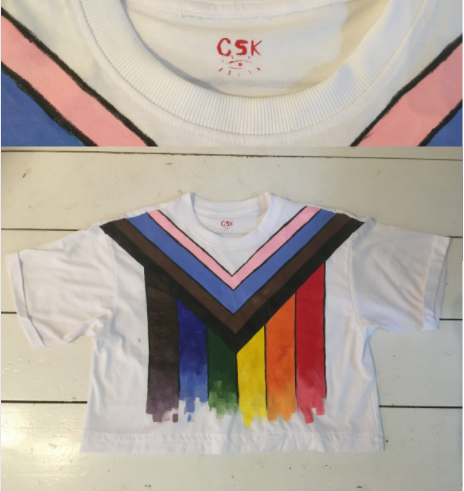

This piece is titled "Looping Jad". It is an animated GIF made of selfies, on which are superimposed the handwritten words "Waiting for Testosterone". It's a glimpse into one aspect of Jad's queer quarantine: the playful/frantic/crushing wait for the next step of their transition. It echoes the weirdness of living a computer-based life, as we are waiting to be allowed outside again.
Within the loneliness and the panic of quarantine, Jad was taking selfies with their computer camera several times a day, inside their room. They did it to check that they were still here and also to beat the boredom. It was also a way to comprehend how others viewed them, now that they are mostly an image in their computer. They have been sending some of those pictures to friends, to say hi. This process felt intimate and relaxed, whereas sharing physical space feels dangerous and unethical.
It was seen as a bittersweet and obsessive experience (maybe also a necessary one) as they kept finding, losing, and building their non-binary body. At the time of submission they were months away from starting their Testosterone HRT, and the relationship Jad had to their body felt super confusing. It is already completely them. It is also a living thing that needs to be changed soon, and this change is present in Jad's mind at all times. It is playful, impatient, and it is definitely very queer.
Jad made a GIF. They like GIFs because they're too frantic to be completely series. It works well with the joyous intensity of being so close from starting Testosterone HRT. The pandemic has put so many people in financial and emotional precarity, and queer people even more so. It is a privilege that they can just 'wait it out', and they let their mind loop in expectation!

Drag Becomes Her
This is a series of life drawings created when Josh's friend was getting into drag during the quarantine. They were preparing for an online performance given that the quarantine has limited their access to normal performance venues; they can't go out, can't perform normally etc. The life drawings themselves were 'blind' drawings (as in, done without looking at the paper), and this queer the mimetic elements of typical observation drawing. This also meant that the lines on the pieces of art were disconnected and this echoes the disconnect many felt in the quarantine.
The act of getting into drag takes hours, and these drawings took minutes, often with very few lines. This subverts the complicated and careful application of drag makeup. The work itself also reflects the queer nature of drag itself, as the subject's drag borrows features from separate elements of femininity and the lack of cohesion on the page reflects the artificial natures and construction of drag performance itself.
Josh is not a drag artist, but is a queer artist, and the subject and process of creating these pictures allowed them a proximity to an aspect of queer culture (i.e. drag) that resulted in a meeting of queer artistic forms. This built on their previous practice of making queer artwork through animation and other multi-disciplinary methods, contributing to their work as a queer artist.
You can find more of Josh's work here.
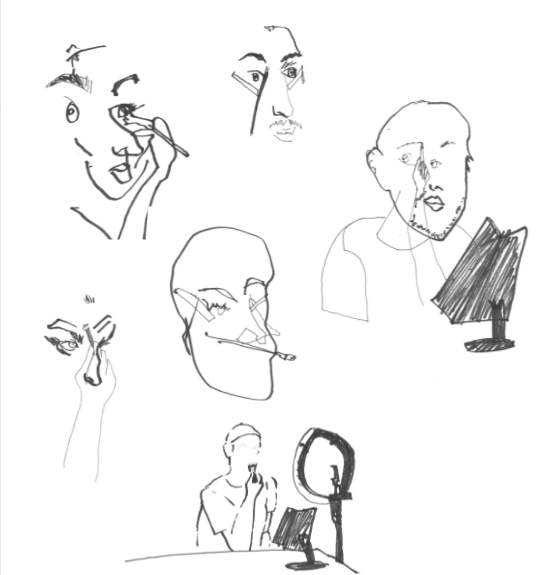
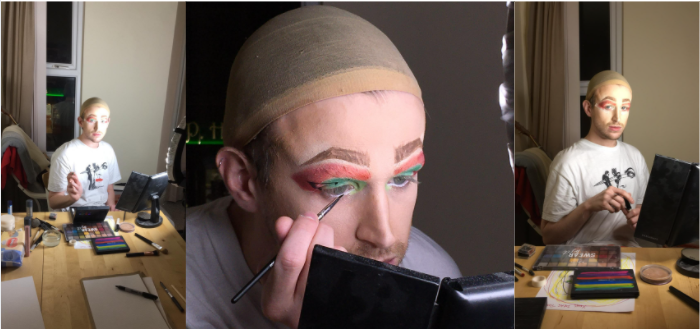

Nastassia is a queer activist and researcher (who is also now a PhD student). The lockdown period in Barbados for her was an extremely tumultuous time - several activist projects that she had planned had to be shelved, and Pride, which is still in its infancy in Barbados, moved online. The poem below is a very personal one that encapsulated Nastassia's experience and anxieties during the time and acts as a representation of her experience as a queer person during that unique period.
Public health terms and
Cliff Martinez score
Bleeding from abstract to reality
Unreal March
From normal to surreal
Comfort foods and
Stringed palm lights
As the yard imprisoned
And frayed lounge chairs
Were the only escape
A million anxieties
And parallel scenarios
Constant dread
And uncertainty
Enrolling in sleep study
To understand the battleground
Relishing slowed time
Then having it sliced by sweaty paranoia
The end moved ever so closer
And I want to bear witness
If I'm spared
From this and even more
Mundane ends.
Nastassia Rambarran
Barbados December 2020
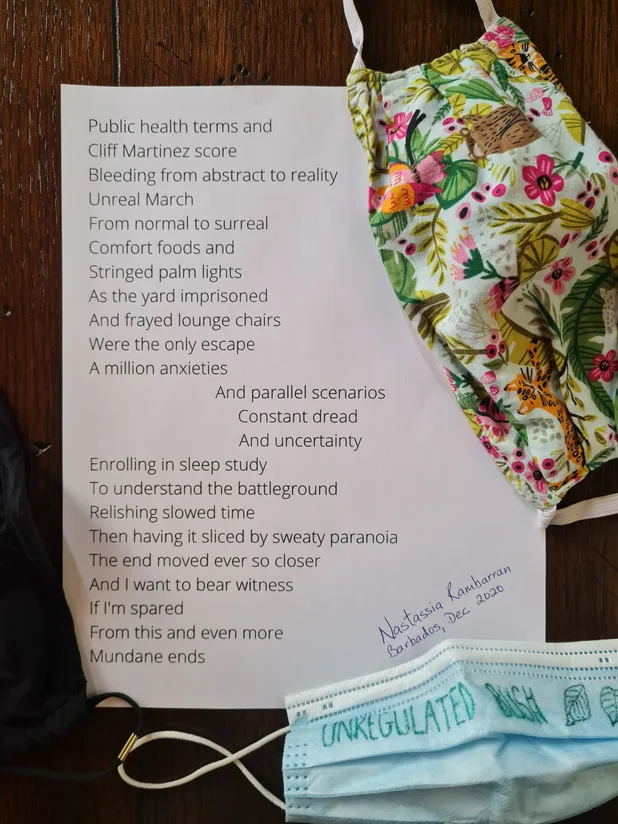

This textile tapestry is called 'Pilgrim' and it forms part of a series that Oliver worked on during lockdown. His aim is to to make a series of six portraits of men with tattoos and how they portray themselves through Instagram. You can find Oliver's Instagram here.
Oliver used the traditional medium of textiles to create his work. He liked that textiles have historically been used to assert identity. Depending on the material, the print, and the texture; a viewer will read the materials in a certain context. This can lead to a judgement about a person's identity.
Oliver enjoys using textiles within his practice to reframe these visual symbols. He enjoys subverting binary narratives to explore gender, sexuality, and identity.
Tattoos can be seen as aggressive, defiant, dominant, and an armour over the skin. It can also display images which are beautiful, displaying emotionally significant stories which are sensitive and reveal the vulnerability of a person. Tattoos are embedded in human history and continue to be a visual record which people proudly display on themselves. Oliver hopes that this series draws attention to some of these themes.
This portrait is based on an image by @ecolina13 on Instagram. Oliver used a combination of visual references from tattoos which are on his (@ecolina13) body and magnified them alongside other images to create a collage of ideas regarding a personal journey alongside the notion of a collective journey.
@Ecolina13 has publicly shown his transition from female to male and also shared other areas of his life; such as his marriage. In this piece Oliver aimed to explore how we individually go through a 'life journey' and how we currently record these series of events by documenting visual records through this social platform.
Further details about how this piece was developed can be found on Oliver's website.
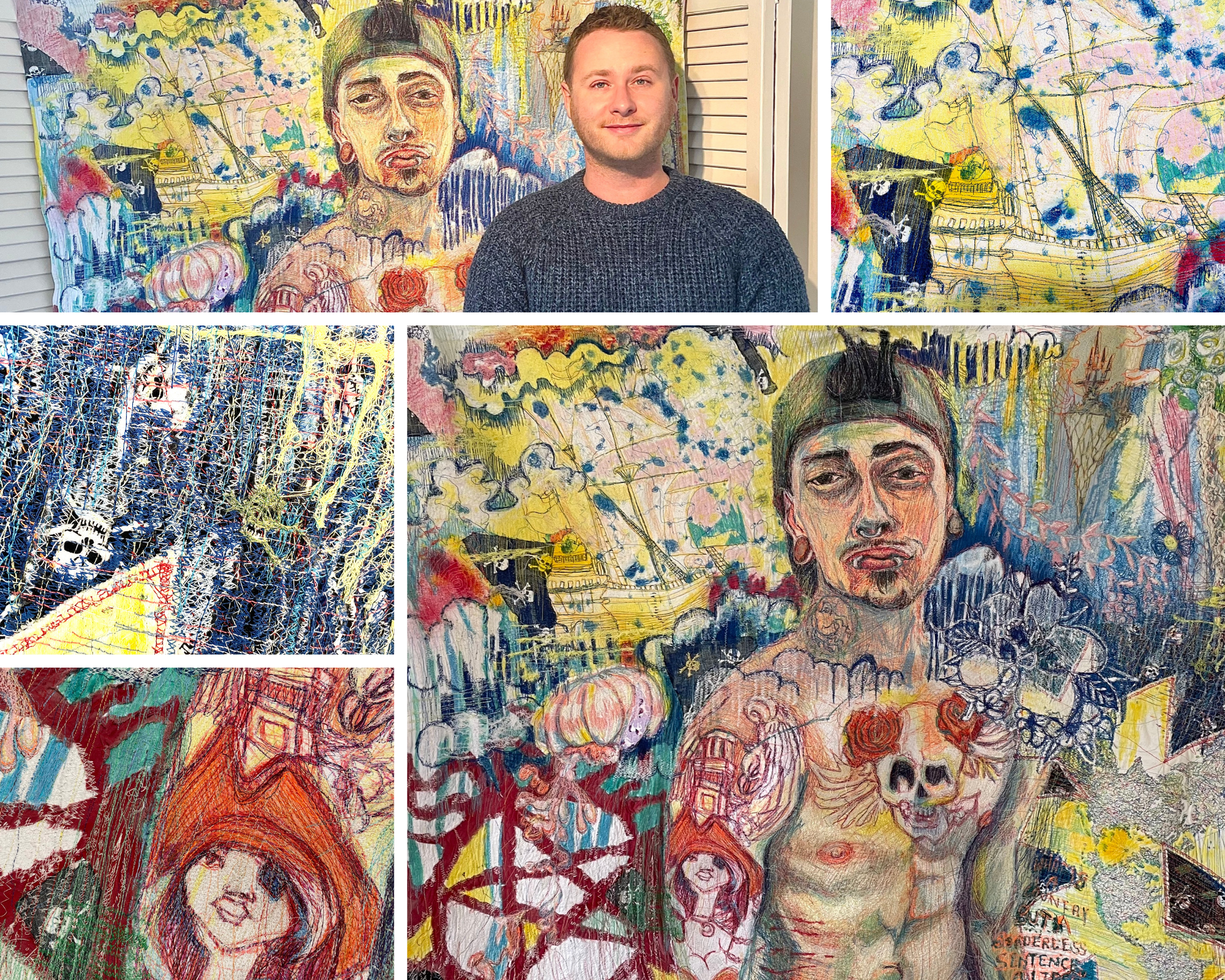

Throughout the pandemic, Tallulah had been returning to David Wojnarowicz's work. Wojnarowicz is one of their favourite artists of all time, documenting the queer experience of the East Village in the 90s through his visual work and literature.
Written just over 30 years ago (1989), his essays from 'Postcards from America' are still unbelievably pertinent to today. Within Tallulah's design, they have reworked and isolated part's of Wojnarowicz's autobiography to highlight his relevance in today's climate. The similarities between the state's reaction to AIDS and the dealing with COVID-19 brings attention to this criminal negligence that has cost so many lives, where profit has always been valued over people. COVID-19 disproportionately affects the oppressed (including queer people), and it is important to find rage and solace through creativity.
Wojnarowicz's writing mirrors so closely the idea of public grief, which is what we've seen in 2020 with rioting and protests all over the world. Tallulah felt depressed by the timeliness of this text, but it also showed them what people have always been angry. People have always been fighting for justice and what is right. So long as this injustice exists, people will continue to fight; Tallulah found comfort in this.
They also drew these comparisons because they did not want his history to be lost either. It is Tallulah's way of refreshing a queer archival past as a form of pedagogy. Reading his work feels like an ancestral teaching to them, so linking it to the current events helped to assure them that we are not alone in our experience; we are rooted by a strong family tree of those before us, sharing our desperation, our loss, our revolutionism.
![an image in black and white of a skyscraper taken from below with a building crane next to it. Mostly these are abstract shapes in the background of the text which is in red. The text reads: 'perfecting their rituals of death screaming in the streets from the edges of abstraction a lover, friend or stranger dump their lifeless form on the front steps [I find it comforting to be able to] mark time and place and history in such a public way'](queering_the_quarantine_artwork.png?maxWidth=626)

This submission consists of a series of photographs that document three abstract structural interventions within the urban landscape. This body of work, created over lockdown from home, is a response to the lack of access to art/queer venues and the increased engagement with local surroundings as a result of daily exercise during periods of social distancing. The separation from queer venues has led to an increased feeling of alienation for many queer people with the lack of safe spaces creating an increased feeling of spectacle and hostility for those of use moving through the world in the strange time of the pandemic.
These physical sculptures that represent the feeling of unconventional and othered beings are directly influenced by the self-consciousness of the physical self as a queer person in a heteronormative environment. In these photographs the feeling of tension between self and environment is the visual focus of the work, and not the objects themselves. The awkwardness of the gesture enacted with these installations, thrown haphazardly into their surroundings, is responsive to the anxiety the visibly queer person feels when moving physically through an unwelcoming environment.


At the time of submission, Tyler was doing a dissertation on the concept of Home and specifically what this means to queer and estranged youth. For their own experience of this, they made some illustrations about what that meant to them during lockdown as a queer person who did not have time with family. They had complete solitary isolation in their "lovely safe queer bubble" and made some illustrations about what that meant to them, the safety from their family, and the space to be alone.
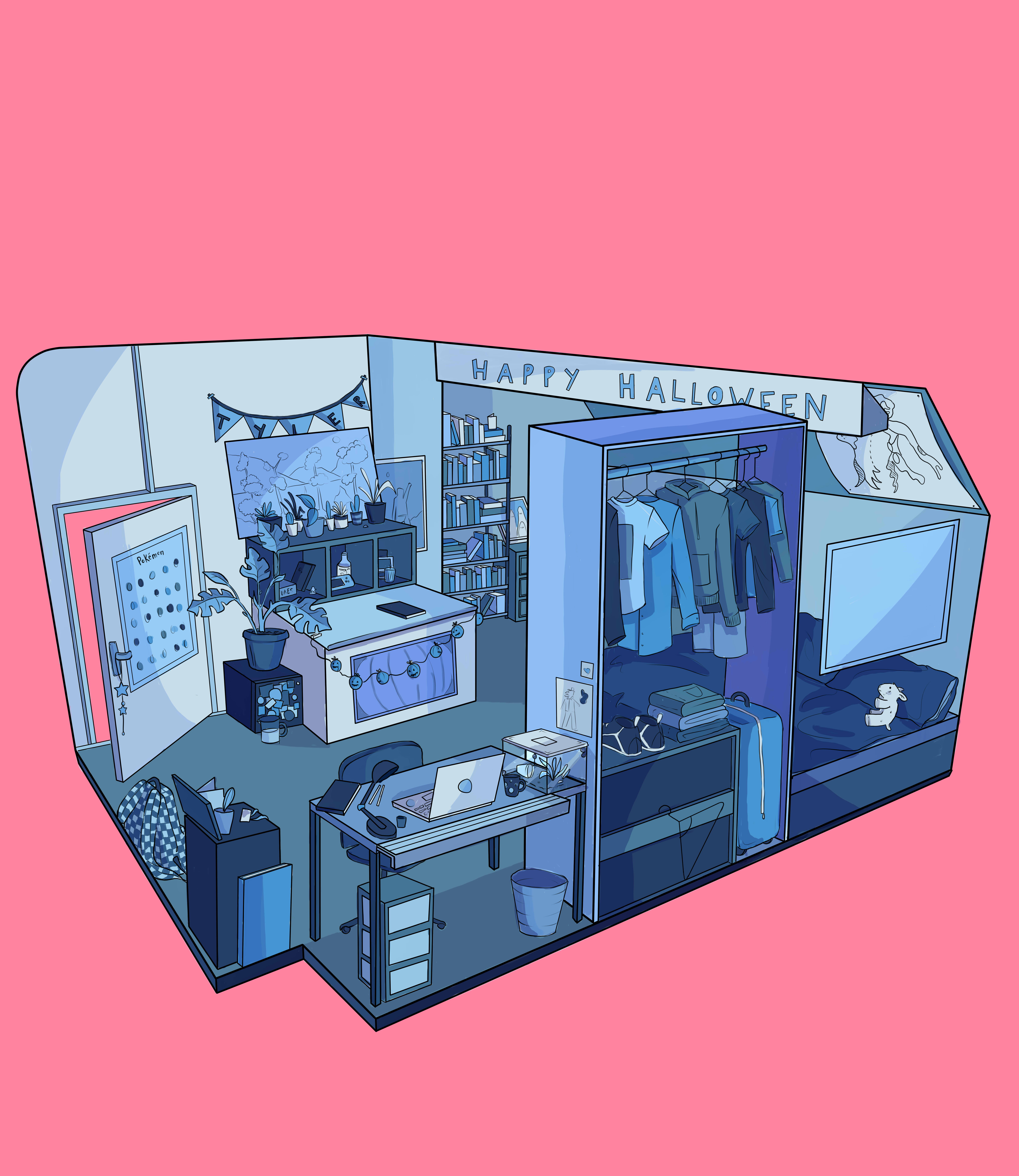

"Public Parts" is a series of woodcut reduction prints that explores the often quite violent act of gendering another person. Gender is a central form of social structuring in contemporary society that is considered natural and innate. As a result, gender is often left unquestioned as a category. However, in engaging in an act of gendering an other, we also directly apply a set of characteristics, forms of behaviour, and expectations for types of interaction onto them. In Usva's experience as a non-binary person who gets frequently gendered as both male and female, being gendered is further accompanied by a lot of expectations of violence and control of the body. One's body, which is often considered private and person, is thus put directly under scrutiny and display. Suddenly private parts become for all to discuss publicly.
In the context of quarantine, being gendered becomes much more complex, layered, and problematic, as we no longer face one another bodily. And when we do get to see others, we are cut off from another via masks, screens, and other safety procedures. As a result, existing visual, behavioural, or interactional cues become void. Moreover, individuals seem to have siloed into bubbles of their own political and social worldviews more than ever, meaning that they are not exposed to different individuals as much as they would normally be. As emotions are running high in the context of the pandemic, facing and gendering queer individuals thus turns into an extremely othering exercise. Asserting one's gender beyond the binary within the boundaries of quarantine becomes even more of a struggle.
